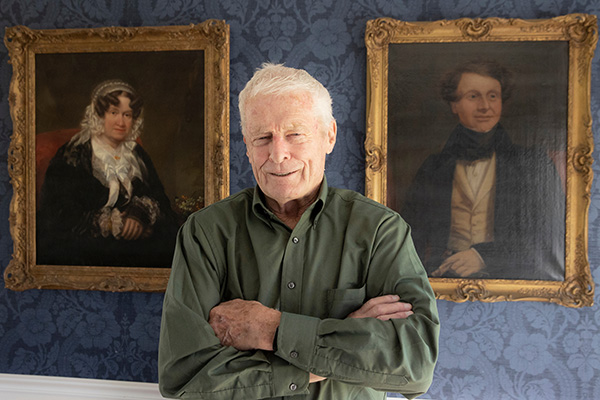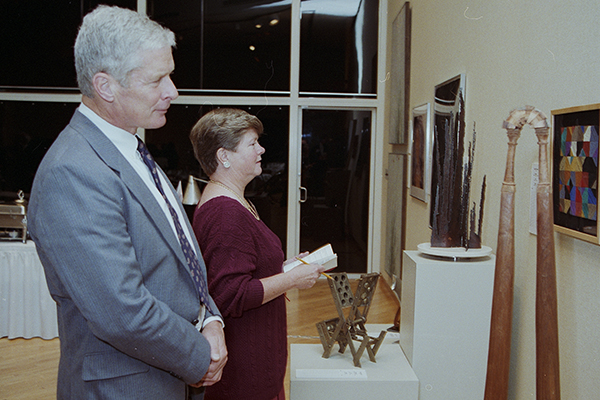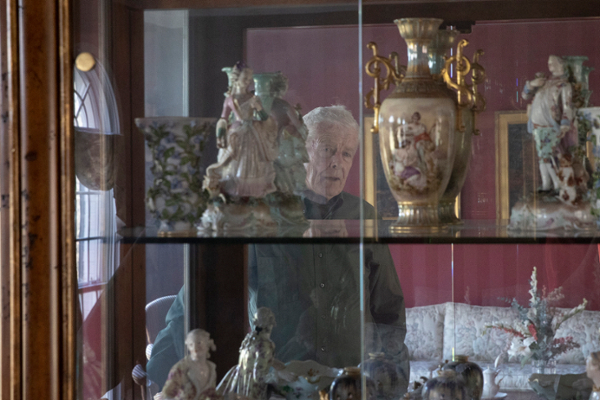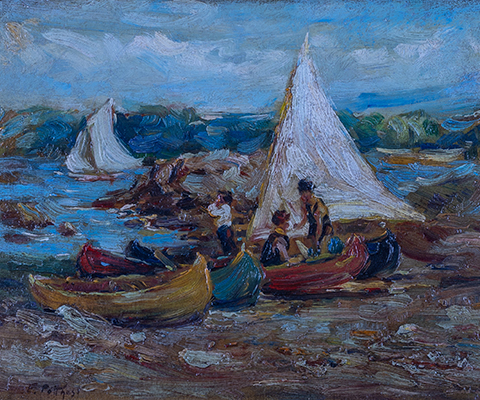Miami University names art museum in honor of longtime donors
Richard and Carole Cocks began donating art nearly 40 years ago

Miami University names art museum in honor of longtime donors
Richard and Carole Cocks began donating artworks to the Miami University Art Museum in 1983, starting with two dozen pieces of fine porcelain from the 18th and 19th centuries. Several paintings followed.
Their recent major financial gift — kept private but the museum’s largest gift ever — has resulted in the 24,000-square-foot teaching museum being named the Richard and Carole Cocks Art Museum. Richard Cocks, who lost his wife in 2012, called it an honor to have the museum named after them.

“I think that’s a nice legacy in my life to be recognized for having supported a great little museum,” Cocks, 87, said recently at his Indian Hill home in suburban Cincinnati. Their latest donation includes 13 artworks for the museum as well as four statues gifted to the College of Creative Arts (CCA).
Located on three acres of scenic sculpture park grounds, the art museum houses five galleries of rotating and ongoing exhibitions and a growing permanent collection of more than 17,500 artworks, covering more than 5,000 years of art from around the world. The museum, which is part of CCA, is accredited by the American Alliance of Museums.
The Cocks’ gift is “truly transformational,” said Jack Green, the Jeffrey Horrell ’75 and Rodney Rose Director and Chief Curator at the museum.
“There's been much discussion about the kinds of enhancements that could expand our audiences, improve our exhibitions, and better preserve our collections for future generations,” Green said. “This gift gives us a wonderful opportunity to begin turning these ideas into reality and also provides a starting point toward a future phased project of renovation and potential expansion, taking into consideration the unique architecture of the building and its surrounding location of our sculpture park.”
The gift sets up the Richard and Carole Cocks Fund to be used to support the art museum, including the renovation and expansion of the building, Green said. The fund also supports the acquisition and maintenance of collections.
Green and Cocks share a vision of elevating the museum — which is free and open to the public — to become one of the best college teaching museums in the country while making it more of a destination for visitors.

Chinese porcelains featured in popular 1998 show
Richard and Carole Cocks are not Miami alumni, but both developed an early and special connection with the museum.
Edna Carter Southard, curator of collections and exhibitions emerita at the art museum and former assistant professor of Art at Miami, started at the museum in 1978, the year it was founded.
“As supporters of the Miami University Art Museum, Carole and Richard regularly attended our annual members' meetings and our gala events for many years,” she said. “I visited them in their home in Cincinnati where I saw their art collection, put together over years of traveling.
“I especially recall their impressive and large Chinese porcelains that I included in the exhibition ‘Earth into Art: Ceramics from Asia,’" she said. “That exhibition was on display from Jan. 27 to Sept. 27, 1998, and it was a very popular and beautiful show.”
Many of those large porcelain pieces are now part of the museum’s permanent collection.
Richard Cocks said he and Carole enjoyed collecting art together.
“My wife and I got in the routine on Saturday mornings. We’d hop in the car at 9 or 10 o’clock after breakfast and spend an hour wandering” through Cincinnati area art shops, he said.
Still among his favorites are the first two paintings they bought — mid-19th century oil paintings of a man and a woman — that hang in his dining room. “They’re unsigned but beautifully done,” he said.
Like most collectors, he and Carole contacted a couple of museums when they were interested in donating some pieces “and very quickly settled on Miami as a place that was interested in accepting those gifts. It worked well for us, and it worked well for them,” he said.
The couple have five grown children, including son Bill, who lives on the West Coast and contributed to this gift.
During a recent visit to Ohio, he and his father drove to Oxford because Bill had never seen the museum.
“To see it from almost every point of the compass, it’s a beautifully sited building, and I think it’s a gem for the college.
“I had actually never driven fully the back lane that goes to the old Western College for Women (now known as Miami’s Western campus),” Richard Cocks recalled. “I couldn’t believe how beautiful it was, that windy road back up through there and the buildings on that old campus.”

A focus on Ohio-based artists
Richard and Carole were members of the American Art Society of Cincinnati, and they became lifetime members of the Miami University Art Museum thanks to their generosity. The recent donation includes paintings and drawings largely by Ohio-based artists.
Green pointed out the museum’s tagline is celebrating artistic diversity, with its primary mission to serve as a teaching museum that engages in dialogue about visual culture.
“Works (from Richard Cocks) that have recently arrived at the museum especially strengthen Miami University's collection of American art of the 19th and early 20th centuries, including by artists from the Cincinnati region,” Green said. “An unfinished portrait by Frank Duveneck called ‘Italian Girl’ is particularly distinctive.
“We’re able to add to the collection works by artists who are not currently represented or will gain complementary works to those already in the collection. For example, the painting by Elizabeth Nourse called ‘Woman and Child’ is particularly strong and adds to paintings in our collection by Ohio women artists. We’re looking forward to being able to use these works in teaching, research, and also in our galleries.”
Green added that an Edward Henry Potthast drawing of a woman and his painting of sailing canoes on a beach will complement other works by Potthast in the collection.
John Weigand, acting dean of the College of Creative Arts and professor of Architecture + Interior Design, said the four donated statues will be placed in the lobbies of Hall Auditorium, Hiestand Hall, Gates-Abegglen Theatre, and the Center for Performing Arts.
He called the couple’s generous gifts “an exciting opportunity” for both the art museum and CCA on so many levels.
“Richard and Carole's naming gift allows us to pursue needed renovations of a nationally acclaimed building and to further establish the museum’s reputation as a top-tier teaching facility,” he said. “The art museum provides amazing learning experiences for Miami students, and the ability to grow these opportunities is testimony to the donors’ love of art and commitment to this mission.”